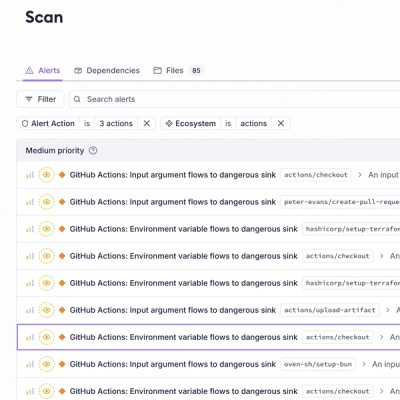
Product
Introducing Socket Firewall Enterprise: Flexible, Configurable Protection for Modern Package Ecosystems
Socket Firewall Enterprise is now available with flexible deployment, configurable policies, and expanded language support.

Flexible JavaScript framework.
In application frameworks state management is used to instantiate and destroy a collection of components and services. Many frameworks go further than this to enforce patterns for how you manage data, write components, declare your routing etc.
Gibbon only provides a framework for state management.
var gibbon = new Gibbon()
class Header{
constructor(){
this.handle = document.createElement(`div`)
this.handle.id = `header`
document.body.appendChild(this.handle)
}
}
class About{
constructor(){
this.handle = document.createElement(`div`)
this.handle.id = `about`
this.handle.innerHTML = `<h1>Swing like noboby is watching.</h1>`
document.body.appendChild(this.handle)
}
}
gibbon.define('app', [ Header ])
gibbon.define('app.home', [ About ])
gibbon.go('app.home')
Defines a new state that can be instantiated.
<String>The name argument is used to define a state. Compose child states using . as a separator.
<Array>The components argument is used to configure a state with an array of Component.
gibbon.define('app', [ Header ])
gibbon.define('app.home', [ About ])
Instantiates a defined state.
<String>The name argument is used to define a state.
A component is a JavaScript Class.
<Bool>The resolved property is used to indicate a component is asynchronous.
The State Lifecycle will wait to destroy components with a property resolved until it's set to true.
<Function>The destroy function is executed at the end of a State Lifecycle.
Useful for cleaning up things like event listeners and intervals.
class Movies{
constructor(){
this.resolved = false
this.init()
}
async init(){
await this.getMovies()
this.createHandle()
this.updateMovies()
this.createMoviesWorker()
this.resolved = true
}
createHandle(){
this.handle = document.createElement('div')
this.handle.id = 'movies'
document.body.appendChild(this.handle)
}
updateMovies(){
this.handle.innerHTML = `<pre>${JSON.stringify(this.movies)}</pre>`
}
createMoviesWorker(){
this.moviesWorker = setInterval(async () => {
await this.getMovies()
this.updateMovies()
}, 10000)
}
getMovies(){
this.movies = await fetch('http://example.com/movies.json')
}
destroy(){
clearInterval(this.moviesWorker)
}
}
When a state is instansiated is constructs each Component from the components array.
States and their components are automatically destroyed after each transition to the next state.
gibbon.define('app', [ Header ])
gibbon.define('app.home', [ About ])
gibbon.define('app.contact', [ EmailForm ])
gibbon.go('app.home')
gibbon.go('app.contact') // 'app.home' is destroyed.
This includes top level state trees.
gibbon.define('app1', [ Header1 ])
gibbon.define('app1.home', [ About2 ])
gibbon.define('app2', [ Header1 ])
gibbon.define('app2.home', [ About2 ])
gibbon.go('app1.home')
gibbon.go('app2.home') // 'app1' and all its children are destroyed.
The same state can be instansiated multiple times in parallel. This is useful when one instance of a state is waiting to be destroyed while another is being created. For example, when a user toggles back and forth between the same pages that have asynchronous dependencies.
gibbon.define('app', [ Header ])
gibbon.define('app.home', [ About ])
gibbon.define('app.movies', [ Movies ]) // Movies is an asynchronous component
gibbon.go('app.home')
gibbon.go('app.movies') // This 'app.movies' state has an instance ID of 'e465a2'
gibbon.go('app.home') // Instance 'e465a2' is still loading and has not yet been destroyed.
gibbon.go('app.movies') // This 'app.movies' state has an instance ID of 'cb198a'.
// 100ms later
// Instance 'e465a2' has finished loading and is destroyed.
// Instance 'cb198a' has finished loading and is the active state.
stateChangeEmits the <State> object that has fully resolved.
Copyright (c) 2019-present, Daniel Kanze
FAQs
Flexible JavaScript framework.
We found that gibbon demonstrated a not healthy version release cadence and project activity because the last version was released a year ago. It has 1 open source maintainer collaborating on the project.
Did you know?

Socket for GitHub automatically highlights issues in each pull request and monitors the health of all your open source dependencies. Discover the contents of your packages and block harmful activity before you install or update your dependencies.

Product
Socket Firewall Enterprise is now available with flexible deployment, configurable policies, and expanded language support.

Security News
Open source dashboard CNAPulse tracks CVE Numbering Authorities’ publishing activity, highlighting trends and transparency across the CVE ecosystem.

Product
Detect malware, unsafe data flows, and license issues in GitHub Actions with Socket’s new workflow scanning support.